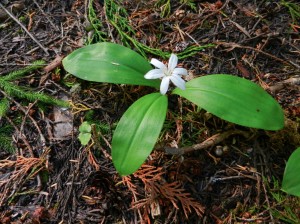
News/Reports
Upper Shuswap Ecological Reserve Overview, Biological and Physical
Physical: This linear reserve lies on the flat but narrow valley bottom of the Upper Shuswap River, which flows from north to south. Moderately steep mountain slopes of the Monashee Range rise to about 2285 m on the west and 2885 m on the east. The floor of the Shuswap River valley has a gradient of only six metres per km in this area. Most of the reserve is flat but fringes of it encompass low terraces and the toes of alluvial fans which are slightly elevated above the floodplain. Surficial deposits are of alluvial origin; soils are believed to be mostly Regosols and Podzols.
Biological: The feature of major interest is the old-growth western redcedar-western hemlock forest which covers almost all of the reserve and includes many cedar trees over two metres in diameter. Cedar attains its best growth in the Interior Cedar-Hemlock Zone on rich, moist, alluvial sites such as this. The typical forest community is the hemlock-redcedar-oval-leaved blueberry-oak fern-trailing raspberry-moss type. Wetter sites in gullies support a cedar-hemlock-devil’s club association. Mosses are abundant throughout the area. Western hemlock is not uncommon throughout the cedar forest; occasional specimens of Engelmann spruce, Douglas-fir, western white pine and western yew occur. Thirteen plant communities have been described.
Shrubby species noted here are Douglas maple, mountain alder, red-osier dogwood, black and red twinberry, baldhip rose, thimbleberry, western mountain-ash, common snowberry, black huckleberry and oval-leaved blueberry. Ferns are well represented, including lady fern, spiny wood fern, Brawn’s holly- fern and bracken. Moisture and shade-loving members of the lily family such as queen’s cup, star-flowered false Solomon’s-seal, clasping twistedstalk, rosy twistedstalk and Indian Hellebore are common.
THREATS
Climate Change: Research on forest ecology projects the possible shift of the western redcedar’s climatic envelope. Forest systems like this could thrive if migration corridors are provided, invasive species are managed, and required nutrients and moisture are available.
Forest harvesting adjacent to the reserve has removed the buffer necessary to maintain conditions within the reserve.
Illegal harvesting of western redcedar from along the forest service road is a concern.
Flora
None listed
Research on forest ecology projects the possible shift of the western redcedar’s climatic envelope. Forest systems like this could thrive if migration corridors are provided, invasive species are managed, and required nutrients and moisture are available.
Forest harvesting adjacent to the reserve has removed the buffer necessary to maintain conditions within the reserve.
Illegal harvesting of western redcedar from along the forest service road is a concern.
A comprehensive natural history report is available as background material for any potential research project.
SCIENTIFIC NAMES OF SPECIES MENTIONED IN THE UPPER SHUSWAP RIVER ER ACCOUNT
alder, mountain (Alnus incana ssp. tenuifolia) blueberry, oval-leaved (Vaccinium ovalifolium) devil’s club (Oplopanax horridus)
dogwood, red-osier (Cornus stolonifera) Douglas-fir (Pseudotsuga menziesii)
fern, bracken (Pteridium aquilinum)
fern, lady (Athyrium filix-fernina)
fern, oak (Gymnocarpium dryopteris)
fern, spiny wood (Dryopteris expansas) hellebore, Indian (Veratrum viride)
hemlock, western (Tsuga heterophylla) holly-fern, Braun’s (Polystichum braunii) huckleberry, black (Vaccinium membranaceum) maple, Douglas (Acer glabrum var. glabrum) mountain-ash, western (Sorbus scopulina)
pine, western white (Pinus monticola)
queen’s cup (Clintonia uniflora)
raspberry, trailing (Rubus pubescens var. pubescens) redcedar, western (Thuja plicata)
rose, baldhip (Rosa gymnocarpa)
snowberry, common (Symphoricarpos albus)
Solomon’s seal, star-flowered false (Maianthemum stellatum) spruce, Engelmann (Picea engelmannii)
thimbleberry (Rubus parviflorus var. parviflorus)
twinberry, black (Lonicera involucrata)
twinberry, Utah (aka red twinberry) (Lonicera utahensis)
twistedstalk, clasping (Streptopus amplexifolius) twistedstalk, rosy (Streptopus lanceolatus var. curvipes) yew, western (Taxus brevifolia)

